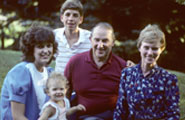Elder Richard G. Scott, who had served as a member of the Quorum of the Twelve Apostles since 1988, passed away on September 22, 2015. He was preceded in death by his wife, Jeanene, who passed away in 1995, and 2 of their children. They are the parents of 7 children and grandparents of 17 grandchildren and 10 great-grandchildren. Funeral services will be held in the Tabernacle on Temple Square on Monday, September 28, 2015, at 11:00 a.m. MDT.
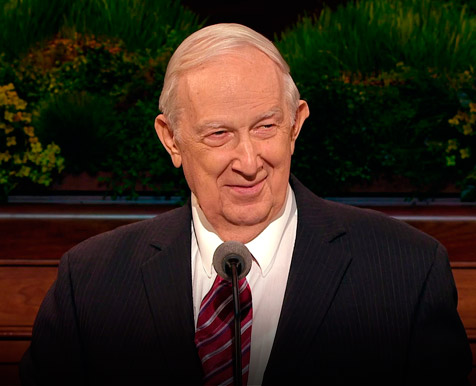
- Thinking about a Mission
- Serving as Mission President
- Continued Service at Home and Abroad
- Marriage
- Selected Teachings
When Richard G. Scott was five years old, he and his family moved from Pocatello, Idaho, USA, to Washington, D.C., where his father worked for the U.S. Department of Agriculture under Elder Ezra Taft Benson of the Quorum of the Twelve Apostles, who was serving as secretary of agriculture.
At the time, Richard’s father, Kenneth, was not a member of the Church, and his mother, Mary, was less active. (Kenneth later joined the Church, and he and his wife became active members, serving in the Washington D.C. Temple for many years.) Richard attended church occasionally, with the encouragement of friends, bishops, and home teachers.
.jpg)
The Scott family (left to right): Gerald, Wayne, Mary, Walter, Kenneth, Mitchel, and Richard.
As a young man, he was outgoing. He was elected high school class president, played the clarinet in a band, and was drum major for the marching band. Although he did well in school and had many friends, he felt lonely and lacked confidence. He realized later as a missionary “that those feelings need not have been part of my life if I had really understood the gospel.”2
When school was out during the summer, Richard found various jobs to earn money for college. One summer he worked on an oyster boat off the coast of Long Island, New York. Another summer he traveled to Utah to work for the forest service cutting down trees; he also repaired railroad cars. Another summer he asked for a job with the Utah Parks Company, even though they had told him they had no openings. He offered to wash dishes for two weeks for no pay. He told the hiring manager, “If you don’t like my work, you don’t have to pay me.” He figured he would at least have a place to stay and food to eat. He was hired after showing initiative to help with cooking as well as washing dishes.3
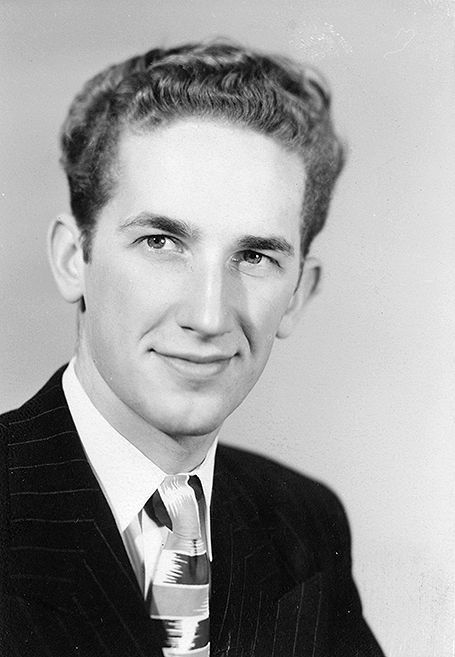
After graduating from George Washington University with a degree in mechanical engineering, Richard served a mission to Uruguay.
After high school, Elder Scott attended George Washington University in Washington, D.C., receiving a bachelor’s degree in mechanical engineering in 1950. He also kept up his musical talents, playing the saxophone and clarinet in a jazz band.
Thinking about a Mission
By age 22, he had not given much thought to serving a mission. But he began to think about it after the young woman he was dating, Jeanene Watkins, told him, “When I marry, it will be in the temple to a returned missionary.”4 He began to pray about serving a mission and visited with his bishop about it. He was called to serve in Uruguay, from 1950 to 1953.
Jeanene studied modern dance and sociology at George Washington University. She graduated in 1951 and then served a mission in the northwestern United States. Two weeks after Elder Scott returned from his mission, he and Jeanene were sealed in the Manti Utah Temple, in July 1953. Of that sealing he shared in general conference, “I have no power to describe the peace and serenity that come from the assurance that as I continue to live worthily, I will be able to be with my beloved Jeanene and our children forever because of that sacred ordinance performed with the proper priesthood authority in the house of the Lord.”5
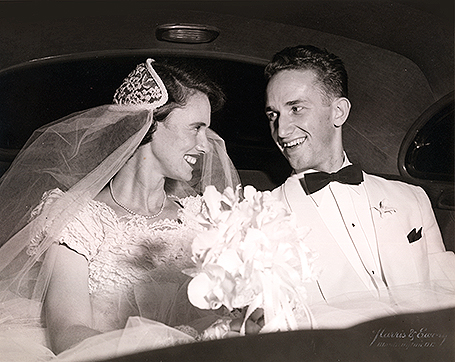
Richard G. Scott married Jeanene Watkins on July 16, 1953.
Many times in his life, Elder Scott made righteous decisions despite opposition and peer pressure. Such was the case with accepting a call to serve a mission. He recalled, “Professors and friends tried to dissuade me from accepting a mission call, counseling that it would severely hamper my budding engineering career. But shortly after my mission, I was selected for the infant Naval Nuclear Program. … At a meeting I was sent to direct, I found that one of the professors who had counseled me against going on a mission was in a significantly lesser program position than I. It was a powerful testimony to me of how the Lord blessed me as I put my priorities straight.”6
About five years after they were married, Elder and Sister Scott underwent what he described as “a growing experience”—a difficult trial that ended up being a blessing in his family’s life. They had a daughter and a son at this time, ages three and two. Sister Scott was pregnant with a baby girl. Sadly, the baby passed away at birth. Then just six weeks later, their two-year-old son Richard died following surgery to correct a congenital heart defect. Elder Scott recounted:
“My father, then not a member of the Church, loved little Richard very much. He said to my inactive mother, ‘I cannot understand how Richard and Jeanene seem to be able to accept the loss of these children.’
“Mother, responding to a prompting, said, ‘Kenneth, they have been sealed in the temple. They know that their children will be with them in the eternities if they live righteously. But you and I will not have our five sons because we have not made those covenants.’
“My father pondered those words. He began to meet with the stake missionaries and was soon baptized. In just over a year Mother, Dad, and the children were sealed in the temple.”7
Elder and Sister Scott later adopted four more children.
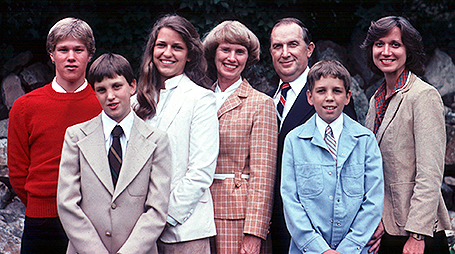
The Scott family. From left to right is Ken, David, Linda, Jeanene, Richard, Mike, and Mary Lee.
Serving as Mission President
Working in the naval program at Oak Ridge, Tennessee, Elder Scott completed the equivalent of a doctorate in nuclear engineering. Because the field was top secret, a degree could not be awarded. The naval officer who invited young Richard Scott to join the nuclear program was Hyman Rickover, a pioneer in the field. They worked together for 12 years—until Elder Scott was called to serve as mission president in Argentina in 1965. Elder Scott explained how he received the call:
“I was in a meeting one night with those developing an essential part of the nuclear power plant. My secretary came in and said, ‘There’s a man on the phone who says if I tell you his name you’ll come to the phone.’
“I said, ‘What’s his name?’
“She said, ‘Harold B. Lee.’
“I said, ‘He’s right.’ I took the phone call. Elder Lee, who later became President of the Church, asked if he could see me that very night. He was in New York City, and I was in Washington, D.C. I flew up to meet him, and we had an interview that led to my call to be a mission president.”
.jpg)
Family photo taken prior to Elder Scott's call to serve as president of the Cordoba Argentina Mission. (Left to right) Mary Lee (age 11), Jeanene, Linda (age 2), Richard, and Ken (age 3).
Elder Scott then felt he should immediately let Admiral Rickover, a hardworking and demanding individual, know of his call.
“As I explained the mission call to him and that it would mean I would have to quit my job, he became rather upset. He said some unrepeatable things, broke the paper tray on his desk, and in the comments that followed clearly established two points:
“‘Scott, what you are doing in this defense program is so vital that it will take a year to replace you, so you can’t go. Second, if you do go, you are a traitor to your country.’
“I said, ‘I can train my replacement in the two remaining months, and there won’t be any risk to the country.’
“There was more conversation, and he finally said, ‘I never will talk to you again. I don’t want to see you again. You are finished, not only here, but don’t ever plan to work in the nuclear field again.’”
“I responded, ‘Admiral, you can bar me from the office, but unless you prevent me, I am going to turn this assignment over to another individual.’”
True to his word, the admiral ceased to speak to Elder Scott. When critical decisions had to be made, he would send a messenger. He assigned an individual to take Elder Scott’s position, whom Elder Scott trained.
On his last day in the office, Elder Scott asked for an appointment with the admiral. His secretary was shocked. Elder Scott entered the office with a copy of the Book of Mormon. Elder Scott explained what happened next:
“He looked at me and said, ‘Sit down, Scott, what do you have? I have tried every way I can to force you to change. What is it you have?’ There followed a very interesting, quiet conversation. There was more listening this time.
“He said he would read the Book of Mormon. Then something happened I never thought would occur. He added, ‘When you come back from the mission, I want you to call me. There will be a job for you.’”8
Elder Scott shared the lesson he learned from this and the many other times he chose the right despite opposition: “You will have challenges and hard decisions to make throughout your life. But determine now to always do what is right and let the consequence follow. The consequence will always be for your best good.”9
Serving in Argentina, President Richard G. Scott was an efficient but compassionate mission president. One of his missionaries, Wayne Gardner, remembers having to make arrangements for a missionary conference located far from the mission home and being responsible to pick up President Scott from the airport. At the last minute, the building Elder Gardner had scheduled for the conference became unavailable. Then he and his companion were late getting to the airport to pick up President Scott. To make matters worse, they forgot to tell the taxi driver to wait for them and there were no other taxis, so they were stranded.
“Even though I could see frustration in the president’s eyes,” Elder Gardner recalls, “he put his arm around me and told me he loved me. He was so patient and understanding. I hope I never forget that lesson.”10
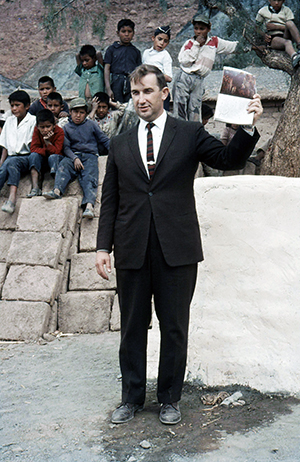
President Scott holds a Book of Mormon in Bolivia.
President Scott relied on the Book of Mormon as a source of inspiration for himself and for the missionaries. On one occasion, a missionary came to his office with a problem. Elder Scott recalled:
“As he spoke, I began to formulate in my mind specific comments to help him resolve his challenge. When he concluded, I said, ‘I know just how to help you.’ He looked eagerly toward me, and suddenly my mind went blank. I could not remember anything I had prepared to tell him.
“In anxiety, I began to thumb through the Book of Mormon I held in my hand until my attention was drawn to a very significant scripture, which I read to him. This occurred three times. Each scripture applied perfectly to his situation. Then, as though a curtain were raised in my mind, I recalled the advice I had planned to give him. Now it had far greater meaning, for it was based on a foundation of valuable scripture. As I concluded, he said, ‘I know that the counsel that you have given me has been inspired because you have repeated the same three scriptures that were given me when I was set apart as a missionary.’”11
Continued Service at Home and Abroad
When the Scotts finished their mission in Argentina and returned to Washington, D.C., Elder Scott continued to work in the nuclear engineering industry. Some of the colleagues he had worked with before his mission asked him to join their private consulting firm. He worked with that company from 1969 to 1977. At church he served as a counselor in a stake presidency and later as a regional representative.

Elder Richard G. Scott and his son Michael examine a nuclear fuel rod near their home in Washington, D.C., in 1977. Photo courtesy of the Deseret News.
In 1977, eight years after being released as mission president, Elder Scott was called to the First Quorum of the Seventy. His first assignments included serving as Executive Director of the Priesthood Department and then as executive administrator in Mexico and Central America. He and his family lived in Mexico City for three years in that assignment. Latin American members appreciated his warm leadership style, his ability to speak Spanish, and his sincere love for the people.
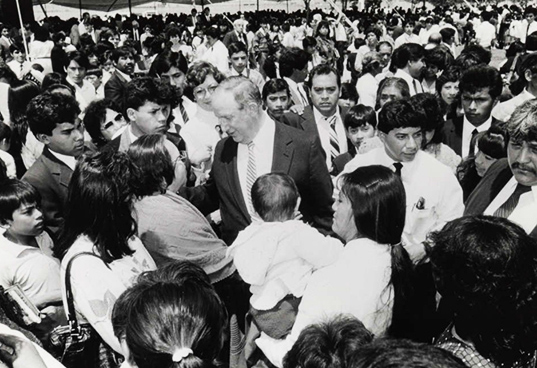
Elder Richard G. Scott presides as the Tecalco Mexico Stake is created June 25, 1989, in Chalco, Mexico. Photo courtesy of the Deseret News.
Even as a General Authority, he was humble enough to learn from local teachers and leaders. He recalled receiving revelation as he sat in priesthood meeting in a branch in Mexico City:
“I vividly recall how a humble Mexican priesthood leader struggled to communicate the truths of the gospel in his lesson material. I noted the intense desire he had to share those principles he strongly valued with his quorum members. He recognized that they were of great worth to the brethren present. In his manner, there was an evidence of a pure love of the Savior and love of those he taught.
“His sincerity, purity of intent, and love permitted a spiritual strength to envelop the room. I was deeply touched. Then I began to receive personal impressions as an extension of the principles taught by that humble instructor. They were personal and related to my assignments in the area. They came in answer to my prolonged, prayerful efforts to learn.
“As each impression came, I carefully wrote it down. In the process, I was given precious truths that I greatly needed in order to be a more effective servant of the Lord.”12
After returning from Mexico, he received another treasured assignment: working with family history. He served as managing director of the Family History Department and then, after he was called to the Presidency of the First Quorum of the Seventy, became Executive Director of the department. Because Elder Scott’s father was a convert to the Church, there was much research to do on that family line, and Elder Scott and his wife, along with his parents, dedicated time to researching their family history.
In the mid-1980s, technology began to play a larger role in family history work, but “even with the aid of computers, there is and always will be a requirement for individual involvement in this work,” said Elder Scott, “so that Church members will have the great spiritual experiences that accompany it, and will feel the spirit of the work.”13
In 1988 came an overwhelming call. He met with President Ezra Taft Benson (1899–1994), who, “with tenderness and love and great understanding,” extended to Elder Scott a call to become an Apostle of the Lord. “I couldn’t help crying,” said Elder Scott of that experience. “And then President Benson very kindly spoke of his own call to give me reassurance. He witnessed how my call had come. I will always remember that thoughtfulness and understanding of the prophet of the Lord.”14 Elder Scott was sustained in general conference two days later, on October 1.
Accepting this call, like the many others he had accepted throughout his life, was his way of keeping a covenant he had made many years before: “When I was very young,” he said, “I made a covenant with the Lord that I would devote my best energies to his work. I have repeated that covenant throughout the years.”15
Marriage
Elder Scott and his wife, Jeanene, enjoyed many activities together, such as bird watching, painting (he used watercolors; she used pastels), and listening to jazz and South American folk music.
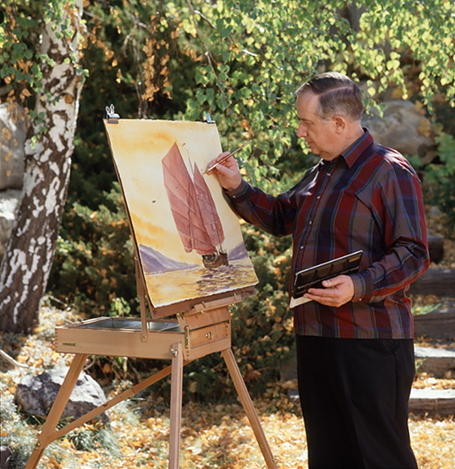
One of Elder Richard G. Scott's hobbies was painting with watercolors.
Those who have listened to Elder Scott’s general conference talks know of his love for Jeanene. He spoke of her often, even after she passed away. In his first general conference talk as a member of the First Quorum of the Seventy in 1977, Elder Scott paid tribute to his wife, “a beloved, cherished companion. … Jeanene has ever been a model of pure testimony, love, and devotion; she is a tower of strength to me.”16
More recently, in an inspiring conference talk on marriage, he recalled the many expressions of love he and Jeanene shared to strengthen their marriage. He concluded: “I know what it is to love a daughter of Father in Heaven who with grace and devotion lived the full feminine splendor of her righteous womanhood. I am confident that when, in our future, I see her again beyond the veil, we will recognize that we have become even more deeply in love. We will appreciate each other even more, having spent this time separated by the veil.”17
Now they are reunited.

Jeanene and Richard Scott in front his painting of Iguazu Falls. Elder Scott often spoke lovingly of his wife, even after she passed away in 1995.
Selected Teachings
Elder Scott’s general conference talks were characterized by a sincere desire to help people through difficult problems: doubt, depression, sin, abuse, and other forms of adversity. “Mine is a message of hope for you who yearn for relief from heavy burdens,” he said in the April 1994 general conference. He then taught Church members how to seek relief by exercising faith in Jesus Christ. (See “To Be Healed,” Ensign, May 1994, 7–9.)
The following teachings are a sample of the breadth of topics he taught over the years:
Forgiveness: “You cannot erase what has been done, but you can forgive. (See D&C 64:10.) Forgiveness heals terrible, tragic wounds, for it allows the love of God to purge your heart and mind of the poison of hate. It cleanses your consciousness of the desire for revenge. It makes place for the purifying, healing, restoring love of the Lord.” (“Healing the Tragic Scars of Abuse,” Ensign, May 1992, 33.)
Faith and character: “Your exercise of faith in true principles builds character; fortified character expands your capacity to exercise more faith. … Strong moral character results from consistent correct choices in the trials and testing of life. Such choices are made with trust in things that are believed and when acted upon are confirmed.” (“The Transforming Power of Faith and Character,” Ensign or Liahona, Nov. 2010, 43.)
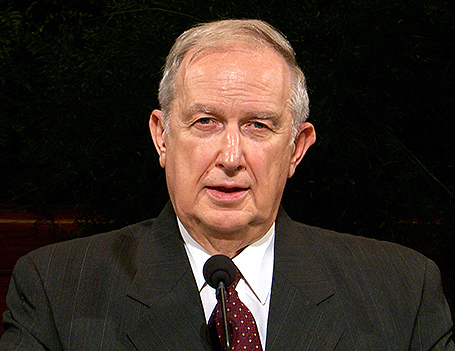
Elder Scott’s general conference talks were characterized by a sincere desire to help people through difficult problems.
Agency and right and wrong: “Our Eternal Father defined truth and established what is right and wrong before the creation of this earth. He also fixed the consequences of obedience and disobedience to those truths. He defended our right to choose our path in life so that we would grow, develop, and be happy, but we do not have the right to choose the consequences of our acts.” (“Healing Your Damaged Life,” Ensign, Nov. 1992, 61.)
Prayer: “He is our perfect Father. He loves us beyond our capacity to understand. He knows what is best for us. He sees the end from the beginning. He wants us to act to gain needed experience:
“When He answers yes, it is to give us confidence.
“When He answers no, it is to prevent error.
“When He withholds an answer, it is to have us grow through faith in Him, obedience to His commandments, and a willingness to act on truth.” (“Learning to Recognize Answers to Prayer,” Ensign, Nov. 1989, 31–32.)
Testimony of Jesus Christ: “The Savior loves each of us and will make it possible for our every need to be satisfied as we qualify by obedience for all of the blessings He wants us to have on this earth. I love and adore Him. As His authorized servant I solemnly testify with every capacity of my being that He lives.” (“He Lives! All Glory to His Name!” Ensign or Liahona, May 2010, 78.)
Notes
- Richard G. Scott, “He Lives,” Ensign, Nov. 1999, 89; Liahona, Jan. 2000, 108.
- In Marvin K. Gardner, “Elder Richard G. Scott: ‘The Real Power Comes from the Lord,’” Ensign, Jan. 1989, 7; Tambuli, Feb. 1990, 18.
- In Gardner, “Elder Richard G. Scott: ‘The Real Power Comes from the Lord,’” Ensign, Jan. 1989, 8; Tambuli, Feb. 1990, 19.
- Jeanene Watkins, in Gardner, “Elder Richard G. Scott: ‘The Real Power Comes from the Lord,’” Ensign, Jan. 1989, 8; Tambuli, Feb. 1990, 20.
- Richard G. Scott, “The Eternal Blessings of Marriage,” Ensign or Liahona, May 2011, 94.
- In “Elder Richard G. Scott of the First Quorum of the Seventy,” Ensign, May 1977, 102–3.
- Richard G. Scott, “Receive the Temple Blessings,” Ensign, May 1999, 27; Liahona, July 1999, 31.
- Richard G. Scott, “Making Hard Decisions,” New Era, June 2005, 4–5, 6; Liahona, June 2005, 8–9, 10.
- Richard G. Scott, “Do What Is Right,” Ensign, June 1997, 53.
- Wayne L. Gardner, in Gardner, “Elder Richard G. Scott: ‘The Real Power Comes from the Lord,’” Ensign, Jan. 1989, 9; Tambuli, Feb. 1990, 21.
- Richard G. Scott, “The Power of the Book of Mormon in My Life,” Ensign, Oct. 1984, 9.
- Richard G. Scott, “To Acquire Spiritual Guidance,” Ensign or Liahona, Nov. 2009, 7.
- In “Elder Richard G. Scott of the Quorum of the Twelve,” Ensign, Nov. 1988, 102.
- In “Elder Richard G. Scott of the Quorum of the Twelve,” Ensign, Nov. 1988, 101.
- In “Elder Richard G. Scott of the Quorum of the Twelve,” Ensign, Nov. 1988, 101.
- Richard G. Scott, “Gratitude,” Ensign, May 1977, 70.
- Richard G. Scott, “The Eternal Blessings of Marriage,” Ensign or Liahona, May 2011, 97.

